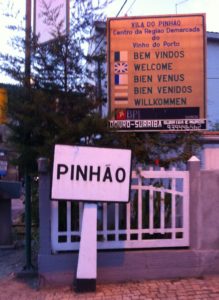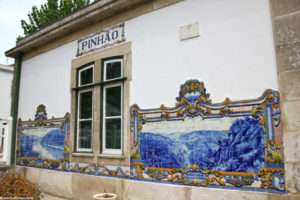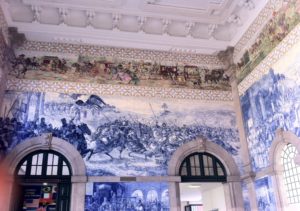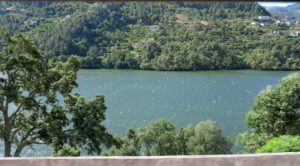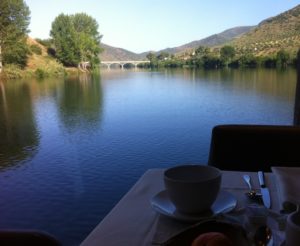In 2017 our group of friends took a Viking cruise along the Douro river in Portugal, which is absolutely beautiful. We greatly enjoyed our holiday, so a couple of years later six of us decided to return and spend a few days in Porto to explore more of the area. One of the things high on our to-do list was to take a train ride along the river and revisit the village of Pinhao which we found very charming during the all-too brief visit from our cruise ship.
Before the coming of the railway, flat-bottomed boats called Rabelos were the only way to navigate the treacherous shoals of the Douro to ship cargo, including grapes and wine, to Porto. The Linha do Douro was built in in the late 19th century to carry agricultural products, seeds and fertiliser to the countryside villages and vine terraces of the interior and, more importantly, to enable the speedy transport of the Douro Valley’s most precious product, Port wine, to the city from whence it was exported all over the world.
We departed on the 0920 train from Sao Bento railway station in Porto, a magnificent building almost completely covered with the typical beautiful blue and white azulejo ceramic tiles so characteristic of Portugal. The ticket prices were advertised at €22 return, very inexpensive for a journey of over 120 km each way. However, when the helpful ticket clerk at the station enquired – very tactfully – whether we might perhaps be just over the age of 65 we were delighted to find that as we were all of mature years we only had to show our passports to be eligible for half-price tickets. Take note Thameslink trains!
Settling back comfortably into our seats on the right-hand side of the carriage for the best view, we moseyed through pleasant although unexciting suburbs for about 40 minutes before reaching the river. From the next two hours the journey was wonderfully scenic as for most of the time the track runs directly alongside the river bank, with dramatic views across it to the serried ranks of grape terraces standing straight and tall in the sunshine. Typical Portuguese hamlets dot the landscape, alongside historic Quintas, the grand port wine estates with names like Sandemans, Taylors and Grahams, evidencing the influence of the British winemakers who, legend has it, actually invented port by adding fortified wine spirit during the fermentation process rather than afterwards, thus making the wine more alcoholic, sweeter and far easier to transport around the world.
Many of the small places we went through were nothing more than tiny halts where a couple of barrels would have been waiting to be loaded on the train in days of yore but Pinhao was one of the very prosperous villages on the Wine Route and has a gorgeous historic railway station beautifully decorated with azulejos. Large panels show local historic scenes before the dams were built along the river to make it more navigable.
On arrival we wandered into the adjacent ‘station café’ on the platform, a delightful outside space with wooden seats under a very ancient olive tree, for a refreshing drink before setting off to explore the village and do a little light souvenir shopping – for me some very appealing wine glasses decorated with grape designs.
Sightseeing accomplished it was obviously time to go in search of lunch. A stroll along the main street offered many possibilities but we eventually succumbed to the blandishments of the enthusiastic owner of the Residencial Ponte Grande who seemed very keen to welcome us into his establishment. The place was extremely busy, mostly with local people, but he seated us at the rear of the room at a large and very grand round table and took our pre-lunch drinks order. I made a feeble attempt to order lager but was quickly disabused of that barbarous idea and presented with a choice of local red or white wine, both of which were very good.
It was then time to order food from a bewildering choice of dishes narrated to us by the jovial proprietor. Due to our lack of linguistic skills we inadvertently managed to order several very large portions of various dishes but as it was all delicious local homemade food it was no hardship to dig in and by dint of sharing most of the dishes a respectable attempt at polishing off virtually everything was made. A digesting interlude then followed, helped by more wine, until a selection of desserts appeared. These duly disappeared, despite loud protestations of ‘I couldn’t eat another bite’.
Next was an unexpected highlight when we were all offered glasses of his father’s own-label port. I am not actually that fond of port but this vintage was very acceptable. So much so that after having another couple of glasses to make sure we really did like it, we all bought a bottle to take home, at a very reasonable price of €15.
The moment of truth then came with the presentation of the bill which we were expecting to be expensive as we had partaken of sizeable quantities of food and wine. No-one was worried about the cost as we had enjoyed it all so much but our second nice monetary surprise that day was that the total was extremely reasonable, something like €35 per person.
After fulsome farewells and extravagant promises to return soon we set off for the nearby station and our train back to Porto, replete with our superb repast. A wonderful day out and we do hope to return soon and enjoy the appetising food and convivial atmosphere at Ponte Grande once the nightmare of the Covid pandemic is over and we can travel again.
